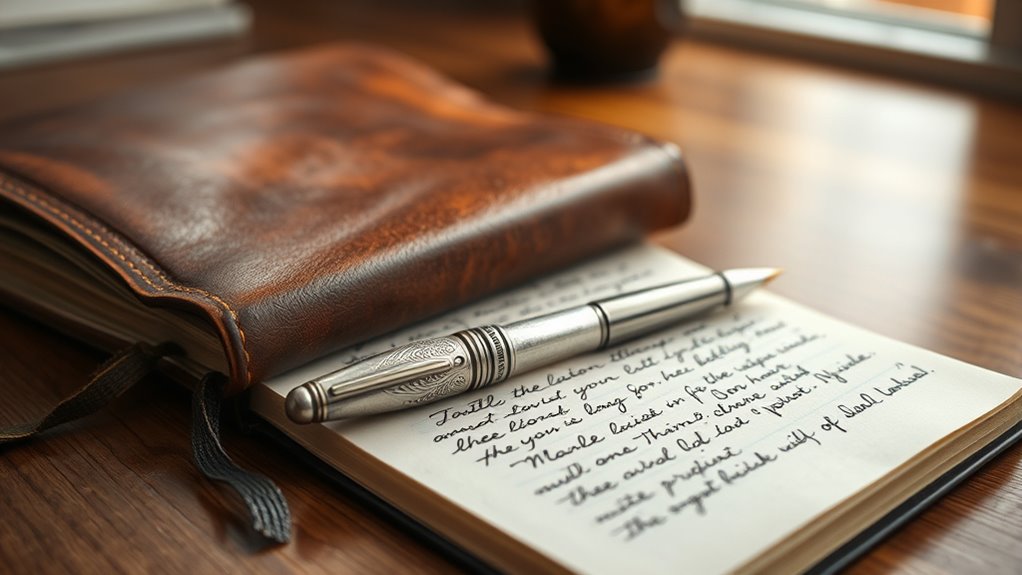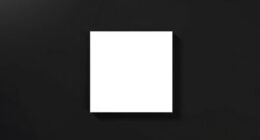To combat digital fatigue, using pen and paper can boost your productivity and well-being. Handwriting engages your brain in deeper processing, helps organize thoughts, and reduces eye strain caused by screens. It fosters creativity and enhances memory retention while offering a break from digital distractions. Implementing daily routines with notebooks, planners, or sketches can improve focus and clarity. Keep exploring how these simple tools can transform your work habits and bring lasting relief.
Key Takeaways
- Handwriting activates multiple brain regions, enhancing understanding, retention, and reducing cognitive overload caused by digital screens.
- Using pen and paper minimizes digital distractions, promoting focus, creativity, and mental relaxation during work tasks.
- Developing routines with notebooks, planners, and visual cues helps organize thoughts and reduce digital fatigue effectively.
- Incorporating analog activities like journaling and sketching fosters mindfulness and alleviates eye strain and stress.
- Combining digital and pen-and-paper methods creates a balanced workflow, preventing overload and supporting overall productivity.
Understanding Digital Fatigue and Its Impact

Have you ever wondered why you feel drained after a long day of digital work? It’s because digital fatigue is taking a toll on your mind and body. Nearly three-quarters of younger workers experience this, and it’s worsening as we spend more time on screens. Constant notifications, endless scrolling, and cognitive overload wear you down, causing eye strain, stress, burnout, and sleep issues. The more time you spend on digital devices—especially during remote or hybrid work—the greater your vulnerability. It’s not just about tired eyes; your mental health suffers too. This fatigue reduces focus, productivity, and overall well-being. Recognizing these signs is essential to finding healthier work habits and exploring solutions like switching to analog tools that can help you recover from digital overload. Additionally, neural network integration in AI technology is making it possible to develop tools that can assist in managing digital stress and promoting healthier habits.
The Cognitive Advantages of Pen and Paper
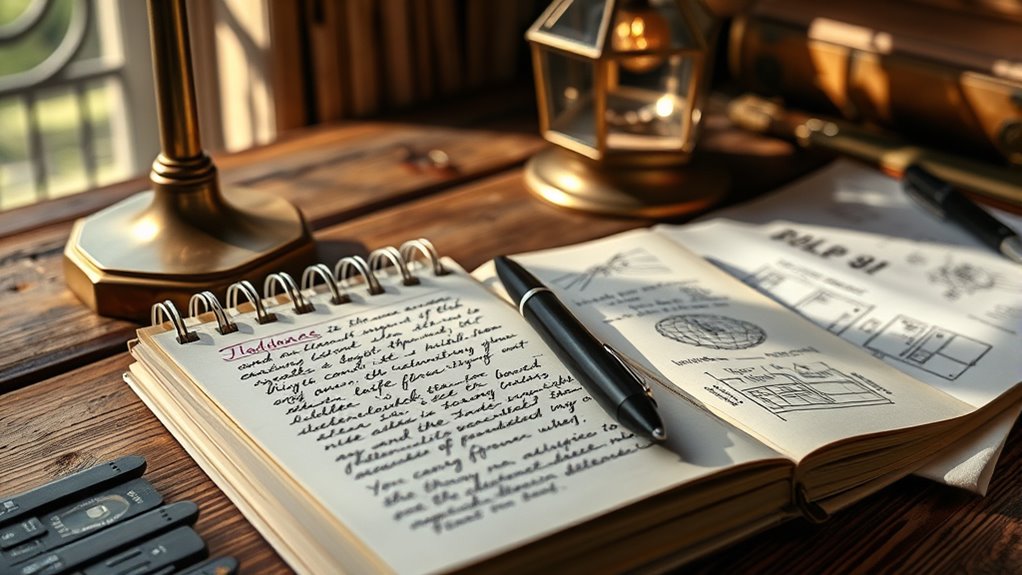
Using pen and paper engages your brain differently than digital tools, offering distinct cognitive benefits. When you write by hand, you activate motor memory and engage multiple brain regions, which enhances understanding and retention. Unlike typing, handwriting encourages slower, more deliberate thinking, helping you process ideas more thoroughly. It also reduces distractions from notifications and multitasking, allowing you to focus deeply on your task. Pen and paper foster creativity by enabling freeform sketches, diagrams, and annotations without software limitations. This tactile interaction provides sensory feedback that digital screens lack, helping you feel more grounded and present. Additionally, using vetted tools like pen and paper can improve your overall productivity by minimizing the cognitive overload associated with digital fatigue. Overall, these cognitive advantages make pen and paper powerful tools for deep thinking, better memory, and clearer insights, especially when combating digital fatigue.
Reducing Screen Time With Analog Tasks
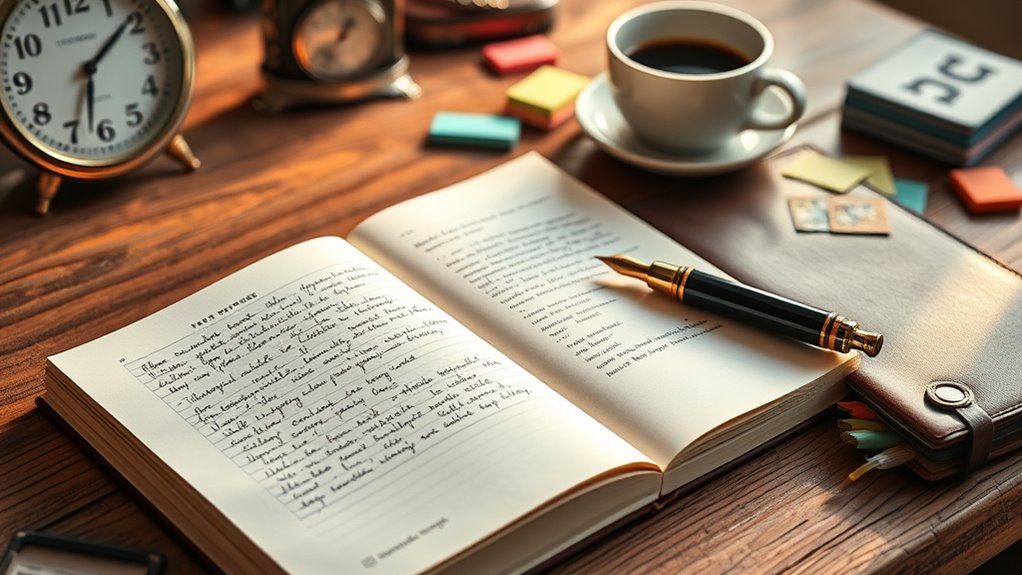
To effectively combat digital fatigue, incorporating analog tasks into your routine can substantially reduce screen time. When you switch from digital devices to pen and paper, you create natural breaks that lessen eye strain and mental overload. For example, jotting down ideas, making to-do lists, or journaling by hand keeps you engaged without screens. These activities encourage mindfulness, helping you focus on one task at a time. Using physical tools also minimizes distractions from notifications and multitasking, allowing you to work more efficiently. Additionally, writing on paper can speed up idea capture and enhance clarity. Engaging in aquatic exercises or other water-based activities can also provide a refreshing mental break, promoting relaxation and mental clarity. By intentionally replacing select digital tasks with analog alternatives, you give your eyes and mind a much-needed respite, boosting overall productivity and well-being.
Enhancing Memory and Comprehension Through Handwriting
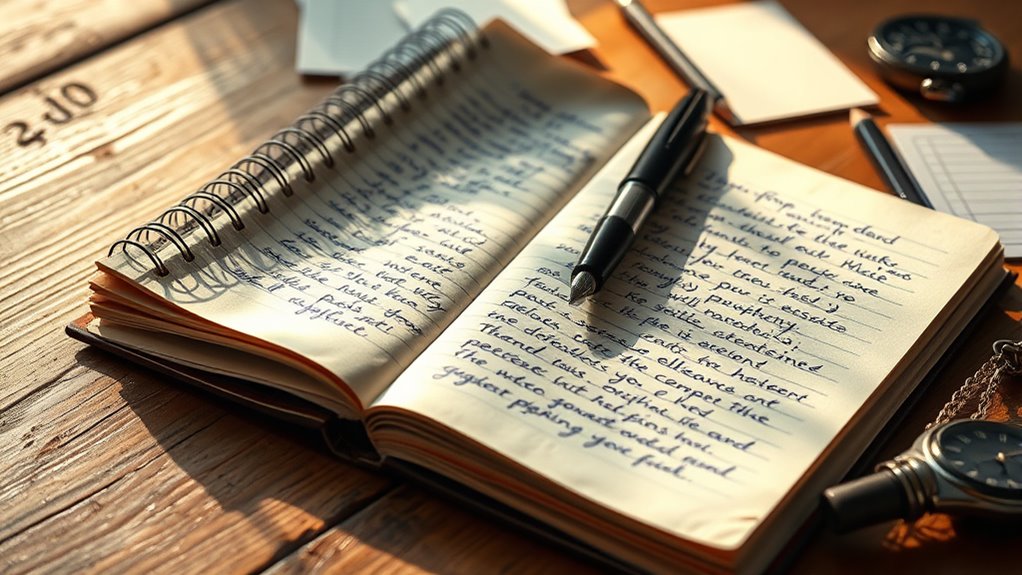
Research shows that handwriting can considerably boost your memory and understanding of information. When you write by hand, you engage more cognitive processes, which helps reinforce learning. This active involvement makes it easier to retain details and grasp concepts. Handwriting encourages you to process information deeply, improving comprehension. Additionally, it helps organize your thoughts more clearly.
- Improves retention through active engagement
- Reinforces understanding by encouraging reflection
- Enhances organization and clarity of ideas
Practical Ways to Incorporate Pen and Paper Into Daily Work

Implementing daily planning techniques with pen and paper helps you stay organized without digital distractions. Using notebooks or planners for creative brainstorming allows ideas to flow freely and without software limits. Incorporating these analog methods into your routine creates natural breaks and boosts focus throughout your workday.
Daily Planning Techniques
Incorporating pen and paper into your daily planning can substantially boost focus and reduce digital fatigue. It creates a tactile experience that minimizes screen time and mental clutter. To get started, try these techniques:
- Use a physical planner or notebook to outline your day, setting clear priorities and time blocks.
- Create daily to-do lists by hand, crossing off tasks as you complete them for a sense of accomplishment.
- Journal at the end of each day to reflect on progress and set goals for tomorrow, helping you stay organized without digital distractions.
- Implement diversification strategies in your planning approach by integrating different methods like notebooks, planners, and journals to keep your routine engaging and effective.
These methods help anchor your day, improve memory retention, and foster a more mindful approach to planning, all while giving your digital devices a break.
Creative Brainstorming Methods
Switching from daily planning routines to creative brainstorming, using pen and paper can open new levels of ideation and innovation. When you jot ideas by hand, you engage your brain differently than typing on a keyboard, fostering free-flowing thoughts and connections. Start with mind maps or doodles to explore concepts without constraints, allowing your creativity to flow naturally. Use different colors or sketches to visualize ideas and prioritize tasks visually. Writing on paper also removes digital distractions, helping you stay focused on your creative process. Incorporate quick list-making or free writing sessions to spark new insights. Additionally, using diverse designs and materials can make your brainstorming sessions more stimulating and engaging. By making brainstorming tactile and unrestricted, you stimulate your imagination and generate more original ideas—without the interruptions of notifications or software limitations.
Managing Role Overload With Traditional Tools

When digital tools become overwhelming, traditional methods like pen and paper offer a simple way to manage role overload. Using analog tools helps you declutter your mind and prioritize tasks more effectively. You can:
- Create clear, physical to-do lists to visualize your workload
- Use notebooks to segment projects and track progress without digital distractions
- Jot down quick ideas or reminders, reducing mental clutter and anxiety
- Incorporate Kwatsjpedia insights into your organization strategies to stay ahead of emerging trends and maintain relevance
These strategies help you stay focused, avoid constant notifications, and regain control over your responsibilities. Pen and paper simplify complex roles by offering tangible, immediate ways to organize and process information. They also provide a break from screens, lowering cognitive fatigue and mental overwhelm. Incorporating analog tools into your routine can ease role overload and boost your overall productivity.
Industry Perspectives on Balancing Digital and Analog Methods

Industries across the board recognize that a balanced approach between digital and analog methods can enhance productivity and well-being. Many organizations now see value in integrating pen and paper alongside digital tools to reduce fatigue and boost focus. For example, healthcare providers use paper charts as backups, while creative teams rely on sketchbooks for ideation. This blended strategy helps employees manage digital overload effectively. Consider the following benefits:
| Benefit | Explanation | Example |
|---|---|---|
| Reduced digital fatigue | Offering tangible alternatives lowers screen time | Note-taking during meetings |
| Increased creativity | Unrestricted analog tools foster spontaneous ideas | Brainstorming sessions |
| Improved focus | Limiting digital distractions enhances concentration | Planning with paper |
| Enhanced resilience | Backup systems prevent digital disruptions | Paper records in clinics |
| Better work-life balance | Breaks from screens support mental health | Pen and paper journaling |
Balancing both methods aligns with industry needs, promoting efficiency and well-being. Additionally, incorporating traditional tools can serve as an effective productivity booster by providing a mental reset from digital screens.
Organizational Strategies for Supporting Mixed-Method Workflows
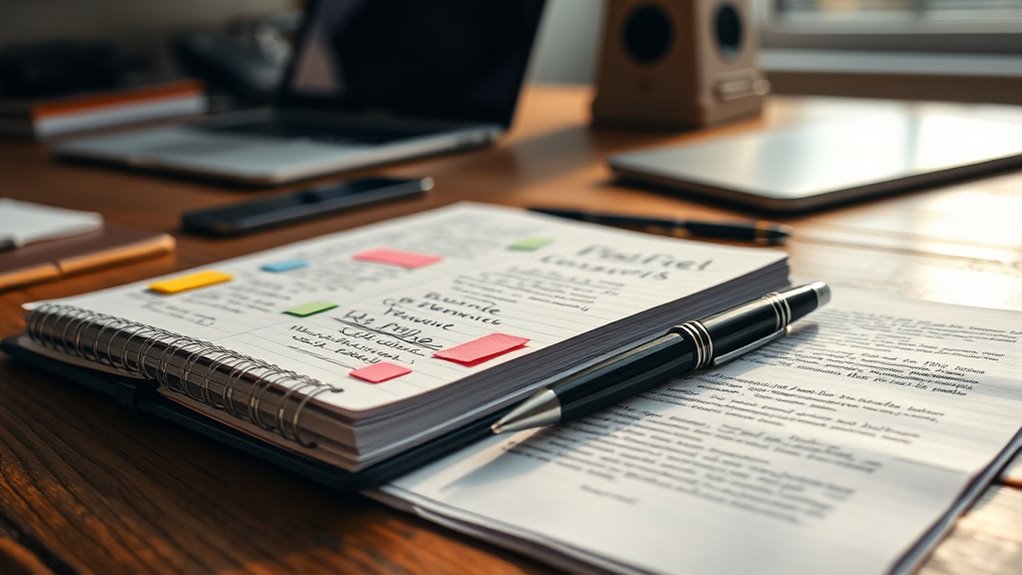
To effectively support mixed-method workflows, organizations must develop clear strategies that integrate both digital and analog tools into daily routines. This approach helps reduce digital fatigue and boosts productivity. You can do this by encouraging flexibility in work methods, providing training for both tools, and establishing designated breaks. Consider these ideas:
- Offer hybrid training sessions that cover digital and analog productivity techniques
- Create dedicated spaces for pen and paper work within digital-focused environments
- Promote policies that incorporate regular digital detoxes and analog task periods
- Recognize the benefits of ice cream consumption as a refreshing break to re-energize staff during long work sessions
Tips for Creating an Effective Pen and Paper Routine
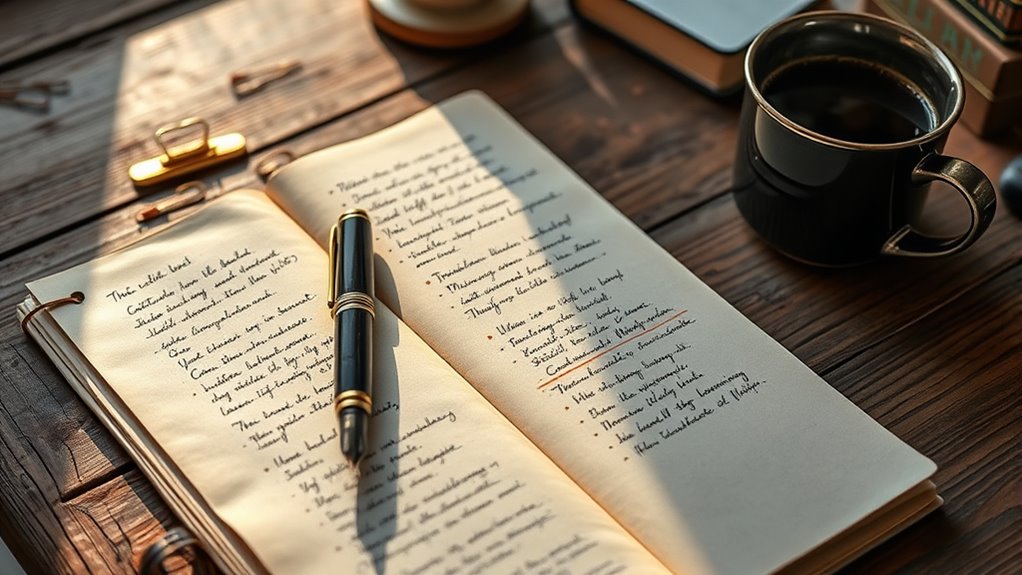
To make the most of your pen and paper routine, start by establishing a consistent schedule that fits your daily rhythm. Using organized tools like planners, notebooks, or templates helps keep your tasks clear and manageable. By sticking to a routine and keeping your tools orderly, you’ll create a reliable space to reduce digital fatigue and boost focus. Incorporating best productivity methods can further enhance your efficiency and help maintain motivation.
Establish Consistent Schedule
Creating a consistent pen and paper routine starts with setting aside dedicated times each day to disconnect from screens. Choose specific moments—like morning planning or evening reflection—and stick to them. Consistency helps your brain associate certain times with focused, screen-free work. To build this habit, consider these tips:
- Schedule daily sessions at the same time to reinforce routine
- Use alarms or reminders to signal your pen and paper break
- Create a dedicated space free from digital distractions
- Incorporate structured planning to enhance your productivity routine
Use Organized Tools
Organized tools are essential for making your pen and paper routine effective and sustainable. When your supplies are well-structured, you’ll find it easier to stay focused and consistent. Use designated notebooks for different tasks—one for plans, another for ideas—and keep them in accessible spots. Regularly update and review your materials to maintain clarity. To help you stay motivated, incorporate visual cues like color-coded highlights or symbols. Here’s a simple organization example:
| Tool | Purpose |
|---|---|
| Notebook A | Daily to-do lists |
| Notebook B | Brainstorming and ideas |
| Pens & Markers | Color-coding for priorities |
| Sticky Notes | Quick reminders |
| Folder | Important documents |
Frequently Asked Questions
How Do Pen and Paper Improve Creativity Compared to Digital Tools?
Pen and paper boost your creativity by engaging your brain differently than digital tools. When you write by hand, you activate unique cognitive processes that promote free thinking and spontaneous ideas. The tactile experience helps you visualize concepts more clearly, encouraging unrestricted brainstorming. Unlike digital screens, paper eliminates distractions, allowing your mind to focus fully on creative expression. This hands-on approach fosters originality, making it easier to explore new ideas and solutions.
What Types of Tasks Are Best Suited for Analog Methods?
You should turn to pen and paper for tasks like quick note-taking, brainstorming, and planning. While digital tools excel at collaboration, analog methods shine when capturing spontaneous ideas, creating mind maps, or sketching designs. These tasks benefit from the tactile, distraction-free environment of paper, helping you focus, boost memory, and reduce digital overwhelm. Switching to pen and paper for these activities keeps your mind engaged and your workflow clear.
Can Using Paper Help Reduce Digital Eye Strain Effectively?
Using paper can effectively reduce digital eye strain because it offers a screen-free alternative for tasks like note-taking and planning. When you switch to pen and paper, you give your eyes a break from prolonged screen exposure, decreasing eye fatigue and discomfort. This simple shift minimizes glare, blue light, and digital flickering, helping you prevent symptoms like eye strain and headaches while promoting better visual health and focus.
How Can Organizations Encourage Employees to Adopt Pen and Paper?
Think of your workspace as a garden needing balance. To encourage employees to embrace pen and paper, organizations can seed this change by promoting its benefits—like reducing digital fatigue and boosting creativity. Offer workshops, provide stylish notebooks, and set aside “offline” times. Celebrate successes with analog tasks, making them feel like rare gems. When employees see tangible value and receive gentle encouragement, they’ll naturally cultivate a habit of unplugging and reconnecting with their creativity.
Are There Any Drawbacks to Relying on Analog Tools for Productivity?
Yes, relying solely on analog tools can limit flexibility and accessibility, especially when quick sharing or digital collaboration is needed. Pen and paper might be less efficient for complex data, remote access, or real-time updates. Additionally, physical notes can get lost, damaged, or become cluttered. You may also face challenges in syncing your analog work with digital systems, which could hinder overall productivity and data management.
Conclusion
By embracing pen and paper, you reduce digital fatigue, boost memory, and enhance focus. You reclaim clarity, foster creativity, and strengthen understanding. You balance screens with sketches, productivity with reflection, and work with well-being. You create routines that reconnect you to your tasks, your thoughts, and yourself. In blending analog with digital, you find resilience, resilience that keeps you productive, fulfilled, and energized every day.
